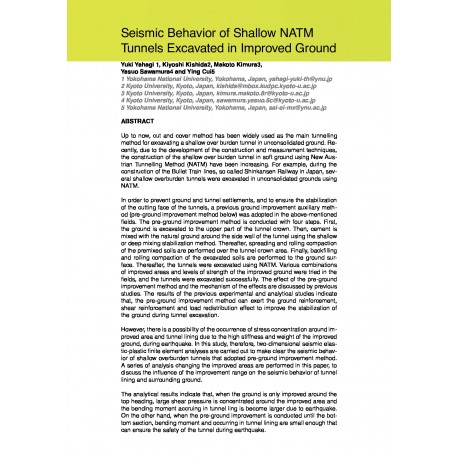Cart
0
0
No document
0,00 €
Total
Document successfully added to your shopping cart
Quantity
Total
There are 0 items in your cart.
There is 1 item in your cart.
Total documents
Total shipping
To be determined
Total
Search & filter
Search for a publication
Search & filter

Seismic Behavior of Shallow NATM Tunnels Excavated in Improved Ground
221_seismic_behavior_of_shallow_
Y. Cui / K. Kishida / Y. Yahagi / M. Kimura / Y. Sawamura
Up to now, cut and cover method has been widely used as the main tunnelling method for excavating a shallow over burden tunnel in unconsolidated ground. Recently, due to the development of the construction and measurement techniques, the construction of the shallow over burden tunnel in soft ground using New Austrian Tunnelling Method (NATM) have been increasing. For example, during the construction of the Bullet Train lines, so called Shinkansen Railway in Japan, several shallow overburden tunnels were excavated in unconsolidated grounds using NATM.In order to prevent ground and tunnel settlements, and to ensure the stabilization of the cutting face of the tunnels, a previous ground improvement auxiliary method (pre-ground improvement method below) was adopted in the above-mentioned fields. The pre-ground improvement method is conducted with four steps. First, the ground is excavated to the upper part of the tunnel crown. Then, cement is mixed with the natural ground around the side wall of the tunnel using the shallow or deep mixing stabilization method. Thereafter, spreading and rolling compaction of the premixed soils are performed over the tunnel crown area. Finally, backfilling and rolling compaction of the excavated soils are performed to the ground surface. Thereafter, the tunnels were excavated using NATM. Various combinations of improved areas and levels of strength of the improved ground were tried in the fields, and the tunnels were excavated successfully. The effect of the pre-ground improvement method and the mechanism of the effects are discussed by previous studies. The results of the previous experimental and analytical studies indicate that, the pre-ground improvement method can exert the ground reinforcement, shear reinforcement and load redistribution effect to improve the stabilization of the ground during tunnel excavation.However, there is a possibility of the occurrence of stress concentration around improved area and tunnel lining due to the high stiffness and weight of the improved ground, during earthquake. In this study, therefore, two-dimensional seismic elastic-plastic finite element analyses are carried out to make clear the seismic behavior of shallow overburden tunnels that adopted pre-ground improvement method. A series of analysis changing the improved areas are performed in this paper, to discuss the influence of the improvement range on the seismic behavior of tunnel lining and surrounding ground.The analytical results indicate that, when the ground is only improved around the top heading, large shear pressure is concentrated around the improved area and the bending moment accruing in tunnel ling is become larger due to earthquake. On the other hand, when the pre-ground improvement is conducted until the bottom section, bending moment and occurring in tunnel lining are small enough that can ensure the safety of the tunnel during earthquake.


